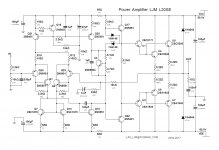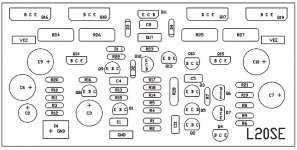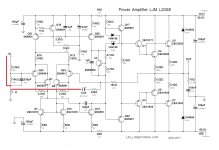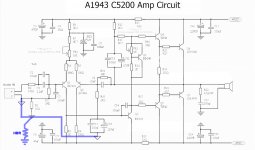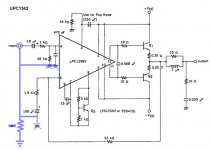Are you doing it as on page 37 on the lower part of the slide? This is the recommended way of doing it.
Normally if you just put a resistor in series with the shield (like its shown in the top half of the slide) it makes the problem worse because the loop current across the resistor causes a noise voltage that is in series with the signal. If you do insert a resistor in series with the shield and it makes no difference, then likely you have no cross-channel ground loop problem - not unheard of if your internal layout is good and the input screens are bonded where they enter the amplifier.
Without seeing your layout, the other explanation might be that any internal cross channel loop is not routing through the shield, but through some other internal path.
The main thing with all these techniques, is to keep loop currents away from the shield.
Normally if you just put a resistor in series with the shield (like its shown in the top half of the slide) it makes the problem worse because the loop current across the resistor causes a noise voltage that is in series with the signal. If you do insert a resistor in series with the shield and it makes no difference, then likely you have no cross-channel ground loop problem - not unheard of if your internal layout is good and the input screens are bonded where they enter the amplifier.
Without seeing your layout, the other explanation might be that any internal cross channel loop is not routing through the shield, but through some other internal path.
The main thing with all these techniques, is to keep loop currents away from the shield.
I know the right way to do it 🙂 I had a hum when I connected to preamp, since doing it the right way required major disassembly and cutting PCB tracks I haven't got around to it yet. I put a 5 ohm resistor in the shield of just one channel, if this makes a difference, and the hum is gone. I appreciate tracking down loops can be complex and it may not be a cross channel ground loop
If it helps to point out, I found the schematic and board layout of this amp on this forum.Ok. It’s very important to note that you cannot simply put a HBR resistor in series with the shield connection. You will make it worse by doing that, because the noise loop current flowing through the resistor is in series with the signal.
See slide 37 on how to do it correctly. When it’s done the right way it will attenuate the noise signal and reduce the noise loop current. A 20 dB improvement is usually what you can achieve.
Note that when I mentioned input jack bonding, it just means ‘connect the two signal grounds together where they enter the housing - do not run any separate wire to the 0V on the PSU!
The input cable routing to get rid of the hum is critical. See slides 61 to 63. If you just run the cables directly from the input jacks to the amp modules (shortest route) you are probably creating a huge loop area inside the amp. Run the two cables together to the fist amp module, and continue the second input cable to the second module. You may well find that if you run it back to the PSU alongside the 0V return, and from the PSU alongside the 0V to the second amp module, you get the best result - you will need to experiment a bit to get the best location though. This is where I recommend the ‘headphone trick’ - See slide 65 and 66.
Don’t forget to rotate you transformer +- 60 degrees to find the noise null point as well.
Attachments
Input shield should go directly to chassis at the connector, don't bring it to the amp board. its for shielding and carries error current. Signal should be in the tip and ring / xlr pins 2 and 3. Google "pin 1 problem".
yep, yet there is connectors having all three pins connected and shielded twisted pair cable used. Why not take advantage of the shield since its there? how is your cabling from the device before this amp? check your connections 😉 connect shield (pin 1) to chassis at the connector and nowhere else including the preceding device. don't connect pin3 to the shield (pin1). Now your "chassis" is extended to protect input wires from the preceding device all the way to the pcb screw terminal.
"... I put a 5 ohm resistor in the shield of just one channel, if this makes a difference..."
HBR should not go to shield but the pin 3 which is the "ground" of unbalanced connection. Again, shield is for shielding keep it separate from audio.
Sorry if I appear to be rude, not my point 🙂 Ive had my share on connecting diy, prosumer and pro gear 🙂 my tip might or might not cure your problem, but please confirm your cabling first. Might get you on the track solving the problemo
"... I put a 5 ohm resistor in the shield of just one channel, if this makes a difference..."
HBR should not go to shield but the pin 3 which is the "ground" of unbalanced connection. Again, shield is for shielding keep it separate from audio.
Sorry if I appear to be rude, not my point 🙂 Ive had my share on connecting diy, prosumer and pro gear 🙂 my tip might or might not cure your problem, but please confirm your cabling first. Might get you on the track solving the problemo
Last edited:
Is your chassis ground ok? seems the is some isolation pad under the point where mains safetyground is connected? Mains safety ground should go directly to the chassis at the connector, its for safety. And to ground error currents in the shielding (chassis). Anyway, a good read on the subject: Noise Reduction Techniques in Electronic Systems by Henry W. Ott
Last edited:
No problem 🙂 That was my comment, but I'm not the OP. In an unbalanced connection the shield is also the signal return"... I put a 5 ohm resistor in the shield of just one channel, if this makes a difference..."
HBR should not go to shield but the pin 3 which is the "ground" of unbalanced connection. Again, shield is for shielding keep it separate from audio.
Sorry if I appear to be rude, not my point 🙂 Ive had my share on connecting diy, prosumer and pro gear 🙂 my tip might or might not cure your problem, but please confirm your cabling first. Might get you on the track solving the problemo
You my find this thread interesting, there are some very good links in there tooAnyway, a good read on the subject: Noise Reduction Techniques in Electronic Systems by Henry W. Ott
Cable shield as a Faraday cage
That's a bare metal spot on the chassis which I filed for clean metal to metal contact. It's the camera flashlight that made it look like something else. 😉Is your chassis ground ok? seems the is some isolation pad under the point where mains safetyground is connected?
I'll try HBR connection recommended and report back.
You still have to twist the power cables together (+,- and 0V), the AC to the PSU board, the AC from the inlet to the track, and the speaker and associated returns. After that, you have to route the input cables inside the amp for lowest noise.
While waiting for the parts ordered to arrive, I decided to delve into 2 other amps I have with the same buzz/hum issue from speakers. It's dead silent when powered on with no input connected, then as soon as it's connected, there is buzz/hum from speakers. My guess is the same ground loop issue I've been dealing with. The images attached are schematics of the two amps with the implementation of HBR in the circuit (blue lines). Do they look right?
Attachments
While waiting for the parts ordered to arrive, I decided to delve into 2 other amps I have with the same buzz/hum issue from speakers. It's dead silent when powered on with no input connected, then as soon as it's connected, there is buzz/hum from speakers. My guess is the same ground loop issue I've been dealing with. The images attached are schematics of the two amps with the implementation of HBR in the circuit (blue lines). Do they look right?
I have found over the years that its best to just have the power amp earth connect to zero volt line.
Any more introduces ground loops.
One earth works best, and more or less doesn't work for me.
Yes, although in the first diagram R1 is the HBR and the triangle symbol shows the connection to the feedback networkDo they look right?
If your amp is silent without any inputs connected but hums when you connect an input (both channels) you probably have a cross channel ground loop. But, it could be coming from your source gear as well so first check this out as follows:-
1. Connect a single RCA cable (say 1-2 metres) from the left channel to the right channel so you are effectively shorting out across the channels.
2. If it hums, move the cable around. If there is no change in the hum level, the cross channel ground loop problem is inside your amplifier.
3. If the level changes as you move the cable around, you have a strong external magnetic field introducing the hum.
4. Assuming the above is all correct and you have no hum, connect only one channel from your source to your amp. If it hums, you have a noise loop emanating from your source gear OR a ground loop in your system.
5. Assuming you have no noise, but when you connect the second channel you have hum (assuming all above is correct and you do not have a ground loop), then you probably have a cross channel ground loop emanating from your source equipment.
1. Connect a single RCA cable (say 1-2 metres) from the left channel to the right channel so you are effectively shorting out across the channels.
2. If it hums, move the cable around. If there is no change in the hum level, the cross channel ground loop problem is inside your amplifier.
3. If the level changes as you move the cable around, you have a strong external magnetic field introducing the hum.
4. Assuming the above is all correct and you have no hum, connect only one channel from your source to your amp. If it hums, you have a noise loop emanating from your source gear OR a ground loop in your system.
5. Assuming you have no noise, but when you connect the second channel you have hum (assuming all above is correct and you do not have a ground loop), then you probably have a cross channel ground loop emanating from your source equipment.
No hum at all.1. Connect a single RCA cable (say 1-2 metres) from the left channel to the right channel so you are effectively shorting out across the channels.
No hum.2. If it hums, move the cable around. If there is no change in the hum level, the cross channel ground loop problem is inside your amplifier.
3. If the level changes as you move the cable around, you have a strong external magnetic field introducing the hum.
It hums. The source (preamp & computer) and amp are plugged into the same power outlet.4. Assuming the above is all correct and you have no hum, connect only one channel from your source to your amp. If it hums, you have a noise loop emanating from your source gear OR a ground loop in your system.
I plugged in my spare amp which is a store bought one and has none of the buzz / hum issue with or without source connected. My 3 amps with such noise issue are all DIY kit amps.5. Assuming you have no noise, but when you connect the second channel you have hum (assuming all above is correct and you do not have a ground loop), then you probably have a cross channel ground loop emanating from your source equipment.
I'll implement the HBR for my L20SE amp once I have the parts and report back.
- Status
- Not open for further replies.
- Home
- Amplifiers
- Solid State
- Pesky 120Hz Buzz / Hum From Speakers
